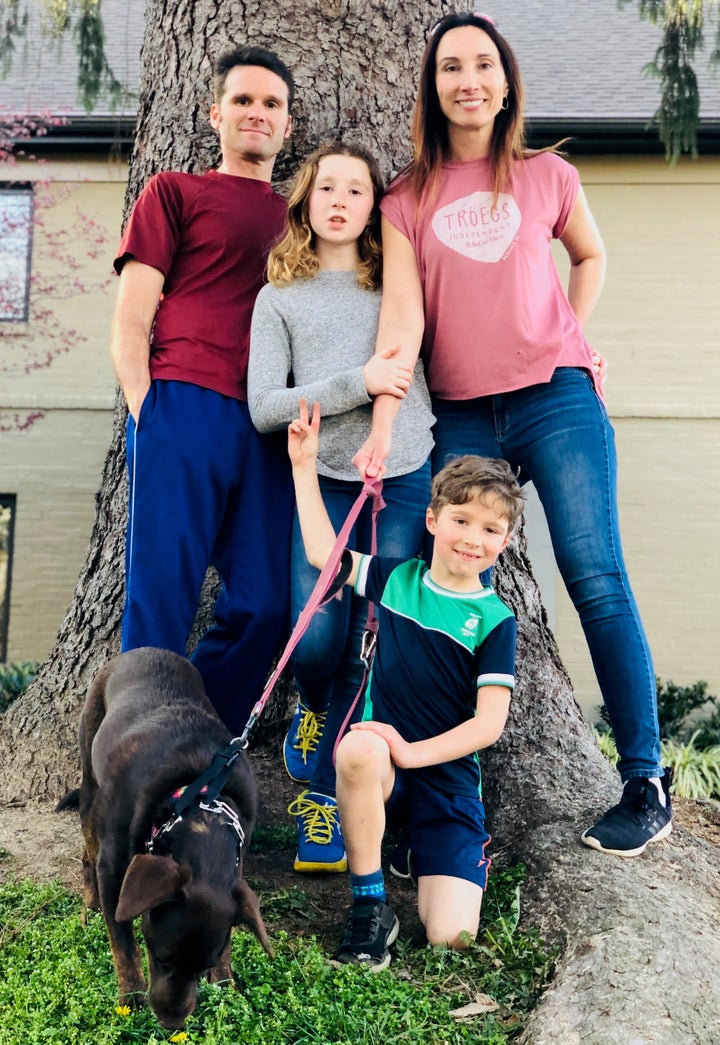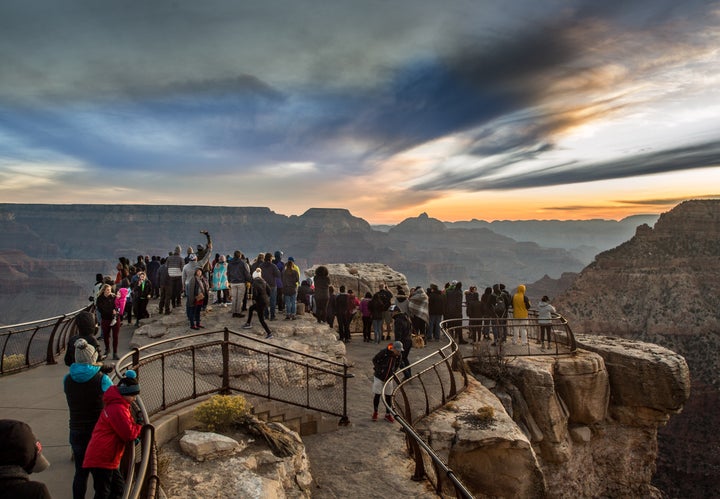Anita Sharma’s family didn’t used to spend much time outside. A typical day involved the hustle to get her young children to school, a full day in the office, and making dinner while the kids watched a show. The coronavirus pandemic has changed that routine.
Now, at midday in Sharma’s home in the center of Washington, D.C., her kids put aside the devices they’re using for online learning. Sharma gets up from her laptop where she’s working remotely at her job in international development. They leash the dog, and the family walks a few city blocks to the 1,700-acre Rock Creek Park. They spend anywhere from 20 minutes to two hours counting birds and identifying them, learning about the surrounding trees and exploring the creek that runs through this part of the woods. That’s on top of riding bikes or shooting hoops in the driveway to start the day, and Sharma’s solo walks to escape the chaos of two kids and two parents trapped in the same house while social distancing.
Where nature was once peripheral, it’s now become an integral part of their days and a saving grace in a time of crisis. Far from unique to the Sharmas, this phenomenon is happening across the country, as families grapple with the threat of the coronavirus and adjust to a new normal that includes being cooped up together for days, weeks — perhaps months — at a time. As the pandemic recasts our understanding of daily life, it may also revive our estranged relationship with nature.
It’s no secret that Americans have become increasingly removed from nature. Adults typically spend an hour or less outside per day — compared to 11 hours per day staring at screens — and that includes the time it takes to walk to the bus on the way to work. Things aren’t looking greener for the next generation: One study suggests that children today spend half as much time outside as their parents did when they were kids.
But in the thick of precautionary measures around the COVID-19 outbreak — with gyms closing, schools shutting down, people working remotely — Americans are finding new motivation to get out for some fresh air. Even while imposing various levels of lockdown, governors from New York to Washington state have stressed that people can still go outdoors to run, walk, hike and bike while practicing safe social distancing.
“We’re compelled to affiliate with nature, which comes to the fore with urgency in times of crisis, because we associate nature with the healing aspects of hope and optimism.”
- Keith Tidball, author of "Greening in the Red Zone"
The sudden zeal for nature comes as no surprise to Keith Tidball, author of “Greening in the Red Zone” and an expert on nature’s role in building resilience in humans after large-scale traumas like deadly hurricanes, nuclear plant disasters and war.
“We spent thousands and thousands of years among the rest of nature ― that’s how we were designed. It’s only in the last couple hundred years that we’ve become separate from it,” he said. “But we’re compelled to affiliate with nature, which comes to the fore with urgency in times of crisis, because we associate nature with the healing aspects of hope and optimism.”
Heal it can. Mounting research shows that spending time in nature — even just 20 minutes per day — can lower stress hormone levels and improve your sense of well-being. These positive effects are so well-documented that some doctors issue “nature prescriptions” to treat anxiety and depression.
Going outside can be especially therapeutic for kids. Nooshin Razani, a pediatrician who runs the Center for Nature and Health at UCSF Benioff Children’s Hospital in Oakland, California, has done research on how trips to the park can buffer the negative effects of childhood traumas such as abuse, poverty or living through a catastrophe. Time spent outdoors improves health outcomes and can boost resilience, including the ability to handle and regulate stress over a lifetime. Getting into nature could have lasting positive effects for children who are currently adjusting to the dissolution of their routines and isolation from their friends.
Elizabeth Townley is a wild and scenic rivers planner for the U.S. Forest Service who’s built her life around stewarding public lands. Even she is seeing the value of green space in a new way. Earlier this week, morale in her house was beyond low. She dropped everything and took the kids to an empty beach near their home on Lopez Island outside Seattle, where they played games, ran in the sand and jumped off logs.
“Everyone was in an awful mood when we left,” she said. “And we came home laughing and singing.”

Sharma is already considering how to continue her family’s new outdoor habits when life returns to normal. “We’ve been thinking of our stints outside as a reset time, and we want to reinforce that going forward. I’d like the kids to feel that they can appreciate nature as a peaceful place, in addition to being a bit of adventure.”
People don’t need a beach or a large city park to feel the benefits of nature. As many states issue stay-at-home and shelter-in-place orders, experiencing “nature” can be redefined as walking down an urban street, looking up at the sky or digging for worms in the yard. All these can offer the same mental and physical benefits, Razani said.
This reevaluation of what counts as nature is especially crucial as some national parks — from the Grand Canyon and Yellowstone to parts of the Appalachian Trail — limit or prohibit visitors to promote social distancing. In Los Angeles, orders to stay home from work sent residents outside in droves; the crowds were so large and so dense that the city had to close parks and hiking trails.
Today’s extraordinary circumstances also underscore how vital these spaces truly are to our well-being.

“I think of this moment as an opportunity to re-see something that we weren’t seeing before,” said Razani. “We’ll realize that the outdoors are treasured spaces with high value, and public lands, like public health, are a really important investment in our mental and physical health.”
There are 857 million acres of public lands across the country, including national, state and city parks, monuments, wildlife refuges and more. Seven in 10 Americans live within 100 miles of a national forest. With the exception of some national parks, these spaces are free to visit ― a boon in this moment of economic downturn.
But America’s wildest spaces are in peril. Public lands stewardship is an unfortunately political issue, an ongoing battle to save untouched expanses under threat from industrial expansion.
The preservation of public lands was a Republican ideal championed by President Theodore Roosevelt at the turn of the 20th century, and Republicans were instrumental in passing protections such as the landmark 1964 Wilderness Act, which shielded 9 million acres of land from development. Today, however, the Republican Party sees conservation as being at odds with economic progress, and public lands as opportunities for resource extraction. That sentiment has only ramped up since President Donald Trump took office: His administration has instituted massive rollbacks of federal land protections and put millions of acres of public land up for lease to oil, gas and mining industries.
Through the lens of the current crisis, however, the original intent in setting these places aside comes into focus, Townley said. “Over the years, the fight for how to manage these lands, what to take from them, when to take it, who can use it and when — it all overshadows the greatest gift of all: These spaces are here for the American people, in sickness and in health.”
For more content and to be part of the “This New World” community, follow our Facebook page.
HuffPost’s “This New World” series is funded by Partners for a New Economy and the Kendeda Fund. All content is editorially independent, with no influence or input from the foundations. If you have an idea or tip for the editorial series, send an email to thisnewworld@huffpost.com.
A HuffPost Guide To Coronavirus
- Stay up to date with our live blog as we cover the COVID-19 pandemic
- Trump rejects New York’s desperate plea for ventilators
- What you need to know about at-home coronavirus Test Kits
- How to file for unemployment if you’ve been laid off
- Got anxiety? Here are 6 cheap mental health resources.
- What to do if you live with someone with COVID-19
- 12 Zoom hacks for work meetings and virtual happy hours
- How to get the most out of the weekend despite coronavirus
- The HuffPost guide to working from home
- What coronavirus questions are on your mind right now? We want to help you find answers.
